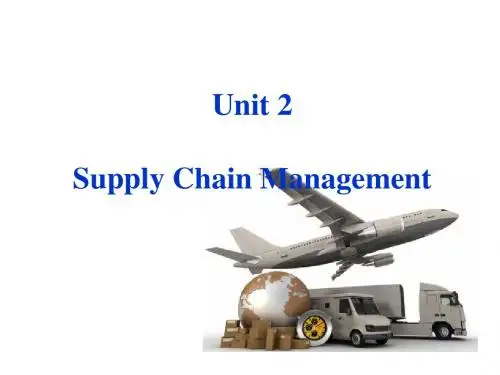当代物流学 第二章 The Supply Chain Management Concept
- 格式:ppt
- 大小:1.84 MB
- 文档页数:36
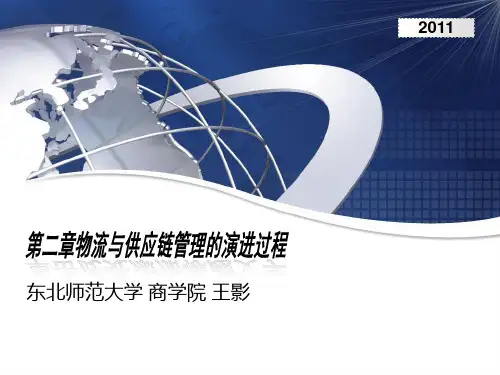
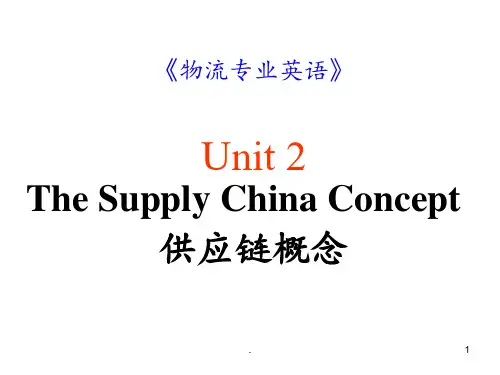
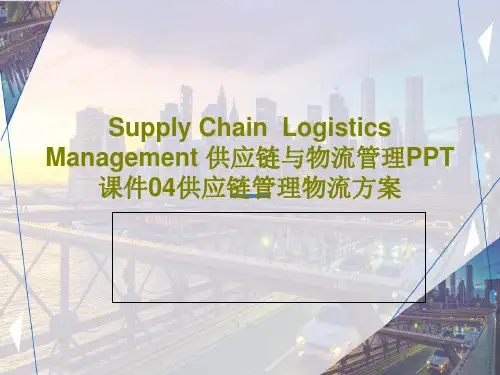

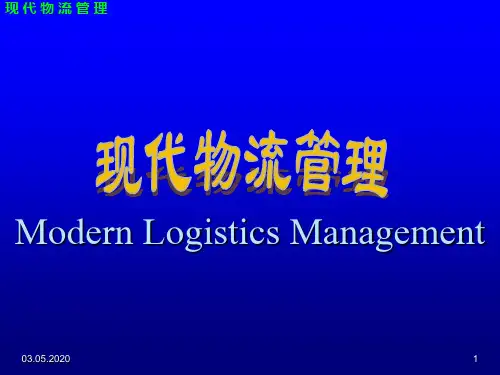
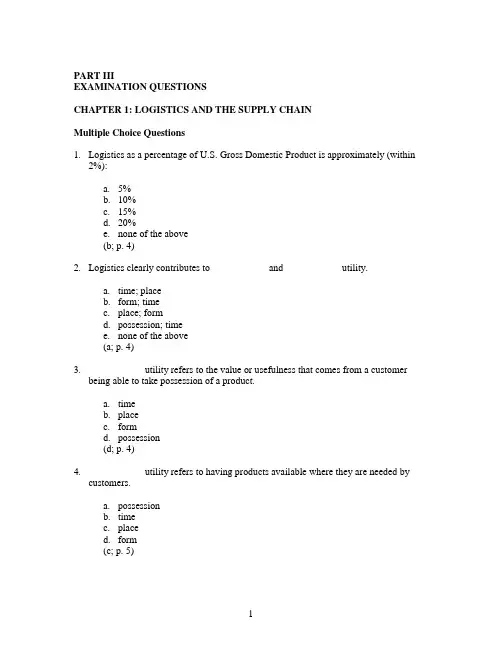
PART IIIEXAMINATION QUESTIONSCHAPTER 1: LOGISTICS AND THE SUPPLY CHAINMultiple Choice Questions1.Logistics as a percentage of U.S. Gross Domestic Product is approximately (within2%):a.5%b.10%c.15%d.20%e.none of the above(b; p. 4)2.Logistics clearly contributes to ___________ and ___________ utility.a.time; placeb.form; timec.place; formd.possession; timee.none of the above(a; p. 4)3.___________ utility refers to the value or usefulness that comes from a customerbeing able to take possession of a product.a.timeb.placec.formd.possession(d; p. 4)4.___________ utility refers to having products available where they are needed bycustomers.a.possessionb.timec.placed.form(c; p. 5)5.All of the following terms have been used to refer to business logistics except:a.business logisticsb.industrial distributionc.logistics managementd.physical distributione.all of the above are correct(e; p. 5)6.“How well a company does what it says it’s going to do” represents ___________.a.efficiencyb.productivityc.leading edge logisticsd.effectiveness(d; p. 6)7.Every customer getting the same type and levels of logistics service refers to___________.a.tailored logisticsb.mass logisticsc.effectivenessd.efficiency(b; p. 7)8.Which of the following is not a reason for the increased importance of logistics?a.growing power of manufacturersb.reduction in economic regulationc.globalization of traded.technological advances(a; pp. 8–10)9.What logistics “outsider” developed the concept of the value chain?a.Donald Bowersoxb.Gus Pagonisc.Michael Porterd.Michael Hammer(c; p. 8)10.The ___________ approach indicates that a company’s objectives can be realized byrecognizing the mutual interdependence of major functional areas.a.supply chainb.systemsc.interfunctionalityd.total cost(b; p. 10)11.The movement and storage of materials into a firm refers to:a.physical distributionb.materials managementc.materials handlingd.inbound logistics(d; p. 10)12.The movement and storage of materials within a firm refers to:a.physical distributionb.inbound logisticsc.materials managementd.procurement(c; p. 10)13.Logistics managers use the ___________ approach to coordinate inbound logistics,materials management, and physical distribution in a cost efficient manner.a.total costb.supply chainc.mass logisticsd.interfunctional(a; p. 11)14.A cost trade-off is a situation where:a.all costs react according to their individual degrees of inflation in the economyb.all costs are reflected as a percentage variation from standard costsc.some costs increase, some decrease, and the net effect is that total costsdecreased.some costs are eliminated by efficient management controls(c; p. 13)15.The cash flow associated with holding inventory is known as inventory ___________.a.turnoverb.valuationc.stockd.float(d; p. 14)16.__________ refers to one location where customers can purchase products from twoor more brand-name retailers.a.intensive distributionb.co-brandingc.co-generationd.selective distribution(b; p. 14)17.Phantom freight refers to:a.paying more for transportation than the actual costte shipmentsc.shipments accepted by non-certified carriersd.freight that “disappears” in transit(a; pp. 15–16)18.Freight absorption refers to:a. a special rate to cover increasing fuel costsb.rates that are higher than other carriers chargec.the ability of cardboard to absorb moistured.transportation payments lower than the actual costs incurred to ship theproduct(d; p. 16)nded costs refer to:a. a product that is shipped via surface transportb. a product that is quoted cost on delivery (COD)c. a prepaid shipmentd. a price that includes both the cost of the product plus transportation to thebuyer(d; p. 15)20.___________ is the excess freight bill paid by customers who live near the shippingpoint.a.freight absorptionb.delivered pricec.phantom freightnded price(c; p. 15)21.In FOB origin pricing, all of the following are true except:a.prices quoted do not include transportation to the consigneeb.marketers can adopt uniform prices on a regional or national basisc.consignees must arrange for the transportation of the purchased productd.the seller always receives the same net from each sale(b; p. 15)22.___________ refers to a situation where the applicable charges are paid at the time ashipment is tendered to a carrier.a.freight prepaidb.freight absorptionc.phantom freightd.FOB origin(a; p. 16)23.___________ refers to charges being paid at the time of shipment delivery.a.freight absorptionb.freight yieldc.freight collectd.FOB destination(c; p. 16)24.The four basic components of the marketing mix include all of the following except:a.priceb.productionc.productd.place(b; p. 14)25.The most common interface between production and logistics generally involves:a.the use of plastic versus wood palletsb.the mode of transportationc.shipment pricingd.the length of production runs(d; p. 18)26.___________ refers to the delay of value-added activities such as assembly,production, and packaging to the latest possible time.a.building blocksb.deferralc.demurraged.postponement(d; p. 19)27.The ownership channel consists of all parties except:a.customersb.manufacturersc.wholesalersd.retailers(a; p. 19)28.The ____________ channel handles the physical flow of product.a.ownershipb.negotiationsc.logisticsd.promotions(c; p. 19)29.Which channel covers the movement of title to the goods?a.promotionsb.logisticsc.financed.ownership(d; p. 21)30.Which of the following is not part of the marketing channel?a.the logistics channelb.the negotiations channelc.the promotion channeld.the finance channele.all are part of the marketing channel(e; p. 19)31.Channel intermediaries:a.assume temporary ownership of the goodsb.fill nichesc.disappear as the market becomes organizedd.tend to lack focus(b; p. 24)32.Intermediaries in the marketing channel perform all of the following functions except:a.supply informationb.match buyers and sellersc.assume temporary ownership of the goodsd.develop and fill niches(c; pp. 23–24)33.The most costly logistics activity in many firms is ____________.a.industrial packagingb.warehousing managementc.order managementd.transportation management(d; p. 27)34.____________ is bringing together similar stocks from different sources.a.accumulatingb.assortingc.auditingd.allocating(a; p. 23)35.____________ refers to breaking a homogenous supply into smaller lots.a.sorting outb.allocatingc.accumulatingd.assorting(b; p. 23)True-False Questions1.Absolute and relative logistics costs in relation to Gross Domestic Product vary fromcountry to country. (True; p. 4)2.Logistics clearly contributes to time and form utility. (False; p. 4)3.The current definition of logistics, as promulgated by the Council of LogisticsManagement, suggests that logistics is part of the supply chain process. (True; p. 6)4.The purpose of logistics is to maximize customer service. (False; p. 7)5.Logistical principles apply only to for-profit organizations. (False; p. 7)6.Two of the five primary activities in the value chain are inbound logistics andoutbound logistics. (True; pp. 8–9)7.The key aspect of the total cost approach is to maximize customer satisfaction. (False;p. 13)8.The Internet has done little to improve logistical effectiveness and efficiency. (False;p. 9)9.Stock-keeping units (SKUs) are the same as line items of inventory. (True; p.10)10.Inbound logistics refers to the movement and storage of materials into a firm. (True; p.10)11.Inbound logistics is synonymous with materials management. (False; p. 10)12.Interfunctional logistics attempts to coordinate inbound logistics, materials manage-ment, and physical distribution in a cost efficient manner that supports anorganization’s customer service objectives. (False; p. 10)mon sense is one of the keys to being an effective logistics manager. (True; p.11)14.The key to the total cost approach is that all relevant cost items are consideredsimultaneously when making a decision. (True; p. 13)15.Logistics offers many companies an important route for creating marketingsuperiority. (True; p.14)16.Co-branding is a retailing strategy that is associated with place decisions. (True; p. 14)17.As a general rule, marketers prefer FOB origin pricing rather than FOB destinationpricing. (False; pp. 15–16)18.Phantom freight and freight absorption are associated with FOB origin pricing. (False;pp. 15–16)19.It is better for a logistics manager to be a generalist rather than a specialist. (False; p.27)20.Stockouts refer to a situation where a company is out of an item at the same time thatthere is demand for that item. (True; p. 18)21.Long production runs sometimes result in excessive inventory of products withlimited demand for them. (True; p. 18)22.Intermediaries assume ownership of goods while the y’re in the marketing channel.(False; p. 24)23.Channel members are usually more concerned about sellers’ needs than with buyers’needs. (False; p. 20)24.The negotiations channel is the one where buy and sell agreements are reached. (True;p. 21)25.There is no linkage between the promotions and logistics channel. (False; pp. 22–23)26.The most significant contribution that the logistics channel makes to the overallchannel process is the sorting function. (True; p. 23)27.The sorting function has four steps. (True; p. 23)28.The sorting function takes place between retailers and the consumer. (False; p. 23)29.A broker is a type of intermediary often associated with the negotiations channel.(True; p 24.)30.In channel negotiations, all parties are presumed to have equal bargaining strength.(False; pp. 20-21)31.Freight forwarders are the most common intermediary in the logistics channel. (True;p. 24)32.Returned products represent one type of activity in the logistical channel. (True; p. 27)33.The key to total cost analysis is to make sure that either transportation or inventorycosts are minimized. (False; p. 13)34.There are relatively few opportunities for employment in the logistics sector. (False; p.27)35.The logistics channel is the most important of the marketing channels. (False; p. 19)。

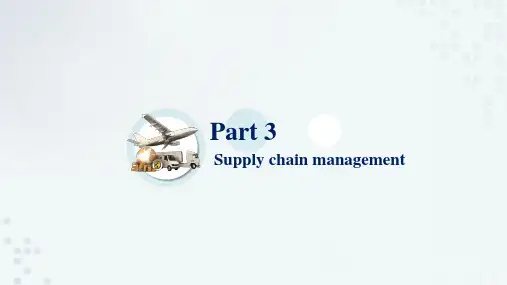
![当代物流学 (2)[16页]](https://uimg.taocdn.com/f872460dce2f0066f4332240.webp)
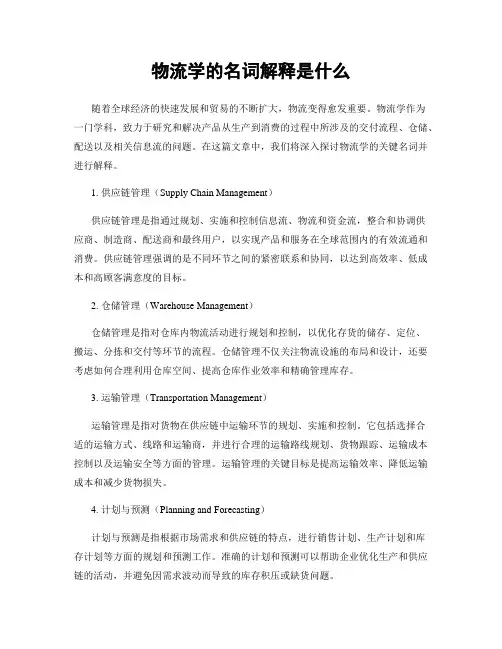
物流学的名词解释是什么随着全球经济的快速发展和贸易的不断扩大,物流变得愈发重要。
物流学作为一门学科,致力于研究和解决产品从生产到消费的过程中所涉及的交付流程、仓储、配送以及相关信息流的问题。
在这篇文章中,我们将深入探讨物流学的关键名词并进行解释。
1. 供应链管理(Supply Chain Management)供应链管理是指通过规划、实施和控制信息流、物流和资金流,整合和协调供应商、制造商、配送商和最终用户,以实现产品和服务在全球范围内的有效流通和消费。
供应链管理强调的是不同环节之间的紧密联系和协同,以达到高效率、低成本和高顾客满意度的目标。
2. 仓储管理(Warehouse Management)仓储管理是指对仓库内物流活动进行规划和控制,以优化存货的储存、定位、搬运、分拣和交付等环节的流程。
仓储管理不仅关注物流设施的布局和设计,还要考虑如何合理利用仓库空间、提高仓库作业效率和精确管理库存。
3. 运输管理(Transportation Management)运输管理是指对货物在供应链中运输环节的规划、实施和控制。
它包括选择合适的运输方式、线路和运输商,并进行合理的运输路线规划、货物跟踪、运输成本控制以及运输安全等方面的管理。
运输管理的关键目标是提高运输效率、降低运输成本和减少货物损失。
4. 计划与预测(Planning and Forecasting)计划与预测是指根据市场需求和供应链的特点,进行销售计划、生产计划和库存计划等方面的规划和预测工作。
准确的计划和预测可以帮助企业优化生产和供应链的活动,并避免因需求波动而导致的库存积压或缺货问题。
5. 信息技术(Information Technology)信息技术在物流学中发挥了重要的作用。
它包括使用电子数据交换(EDI)系统、物联网技术、供应链管理软件和智能仓储设备等工具,以提高物流信息的处理和传递效率,加强跨部门和跨企业之间的协作和协调。
6. 反向物流(Reverse Logistics)反向物流是指在产品生命周期结束后,对各种退货、退款、返修以及回收再利用等与之相关的流程进行管理。
